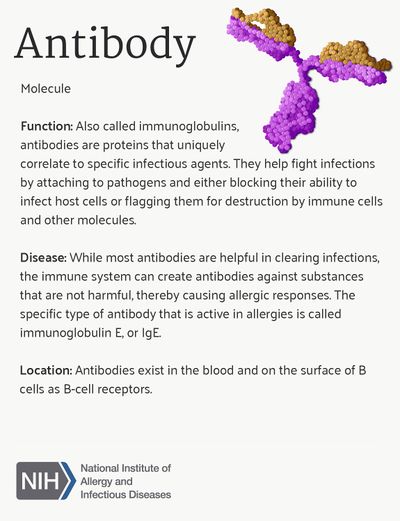Immunoglobulins (Ig)
This article or area is currently under construction and may only be partially complete. Please come back soon to see the finished work! (4/12/2020)
Original Editor - Lucinda hampton
Top Contributors - Kirsten Coutts, Lucinda hampton, Kim Jackson and Nupur Smit Shah
Introduction[edit | edit source]
Immunoglobulins (Ig) or Antibodies: Glycoproteins that your immune cells make to fight off bacteria, viruses, fungi, parasites, cellular antigens, chemicals, and synthetic substances.
- Are produced by plasma cells.
- B cells are instructed by specific immunogens, for, example, bacterial proteins, to differentiate into plasma cells, which are protein-making cells that participate in humoral immune responses.
- Immunoglobulins constitute about 20% of the protein in plasma[1]
- They act as a critical part of the immune response by specifically recognizing and binding to particular antigens, such as bacteria or viruses, and aiding in their destruction.
- The antibody immune response is highly complex and exceedingly specific.
- Antibody tests are used to detect disease-specific antibodies in a blood sample.[2].
- WHO officially coined termed the term Immunoglobulins for antibodies in 1964. [3]
5 types of immunoglobulins in humans[edit | edit source]
There are five main types of immunoglobulins, each immunoglobulin can have a different binding site that matches a specific antigen. The body can produce an infinite number of binding sites to bind to antigens.
Immunoglobulin G (IgG)
- Accounts for around 75% of all antibodies in the human body.
- Depending on the antigen, IgG can either tag a pathogen so other immune cells and proteins will recognize it, or it can promote the release of toxins to directly destroy the microorganism.
- IgG can sometimes trigger an undesirable response in people with autoimmune disorders.
Immunoglobulin A (IgA)
- Accounts for 15% of all antibodies in the human body
- Primarily found in mucosal tissues (eg mouth, vagina, and intestines) as well as in saliva, tears, and breast milk.
- Produced by B cells and secreted from the lamina propria (a thin layer within mucosal tissues).
- One of the body's first-line defenses against infection - it binds to pathogens tagging them for destruction and preventing them from sticking to the epithelium (which lines the body's tissues).
- Associated with hypersensitive reactions in people with celiac disease and several other autoimmune disorders.
Immunoglobulin A (IgM)
- Immunoglobulin M (IgM) is also one of the first antibodies recruited by the immune system to fight infection.
- IgM populations rise very quickly when the body is first confronted with an infectious organism, and then they plummet as IgG antibodies take over.
- IgM is also produced by B cells and, when bound to a pathogen, will spur other antibodies and immune cells into action.
- A subset of IgM helps B cells "remember" a pathogen after it has been destroyed. If you were to become re-exposed to the pathogen later, your immune system should respond more quickly due to your memory B cells.
Immunoglobulin E (IgE)
- The antibody responsible for the allergic response that is mostly found in the lungs, skin, and mucosal membranes.
- Produced by B cells secreted by lymph nodes or other lymphoid tissues situated near the site of the allergen.
- When IgE binds to an allergen, it triggers a cascade of events. Basophils and mast cells (subtypes of WBCs,) degranulate and release histamine, an inflammatory compound, into the bloodstream.
- IgE also helps to protect the body from parasitic infections, including helminths (parasitic worms).
Immunoglobulin D (IgD)
- Accounts for only around 0.25% of antibodies in the human body.
- Important in the early stages of the immune response.
- Unlike other antibodies, it does not actively circulate but binds to B cells to instigate the immune response. As a signaling antibody,
- IgD helps incite the release of front-line IgM to fight disease and infection.
- The least understood antibody, with little known about how it might participate in other parts of the immune system[4]
Sub Heading 3[edit | edit source]
Resources[edit | edit source]
- bulleted list
- x
or
- numbered list
- x
References[edit | edit source]
- ↑ Vaillant AA, Ramphul K. Immunoglobulin. InStatPearls [Internet] 2019 Nov 10. StatPearls Publishing.Available from:https://www.ncbi.nlm.nih.gov/books/NBK513460/ (last accessed 3.12.2020)
- ↑ Thermofischer scientific Immunoglobulins Available from:https://www.thermofisher.com/au/en/home/life-science/antibodies/antibodies-learning-center/antibodies-resource-library/antibody-methods/introduction-immunoglobulins.html (last accessed 3.12.2020)
- ↑ Easybiology antibodies Available from: https://www.easybiologyclass.com/difference-between-antibody-and-immunoglobulin/ (last accessed 3.12.2020)
- ↑ Very well health Antibodies Available from:https://www.verywellhealth.com/antibody-isotypes-3132614 (last accessed 3.12.2020)







